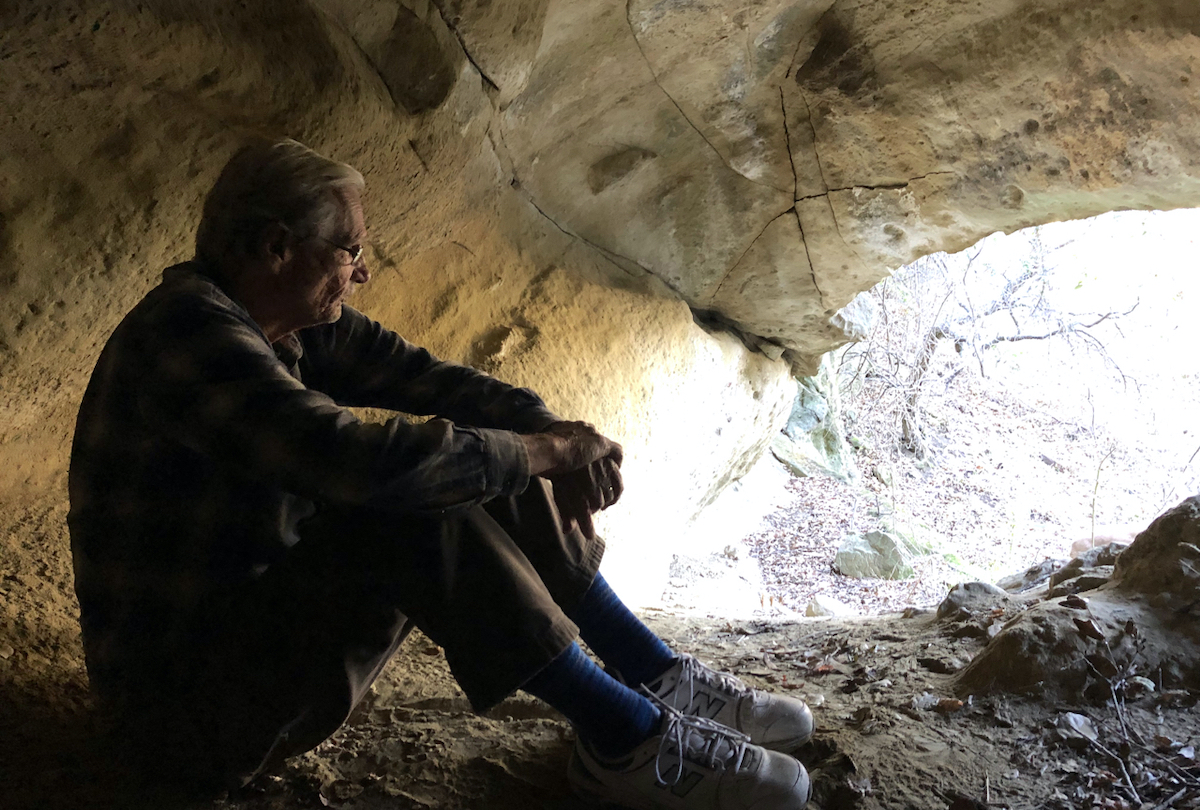Santa Barbara’s ‘Sitting Cave’
A Visit to Fernando Librado’s Abode

Fernando Librado’s so-called “sitting cave” is located in the local mountains, a hidden spot chosen carefully by a man who knew the area well. A member of the Chumash tribe whose parents were from Santa Cruz Island, Fernando was born in 1839, baptized at the mission in Ventura, then raised at Mission La Purisima. Sometimes known as Kitsepawit ― he may have been given the name Librado in acknowledgment of his ability to read ― he spent much of his later life on ranches near Lompoc and Las Cruces, working as a sheepherder and handyman, with an occasional expedition to Tranquillon Peak (on what is now Vandenburg Space Force Base) to gather medicinal plants endemic to its slopes.
My anthropologist friend Larry Spanne had boyhood memories of the sitting cave. “My dad took me out there,” he said. “The guy that told my dad and me about it was John Begg, and John Begg knew Fernando personally, and I interviewed him. He told me Fernando was the ranch midwife, medicine man, and doctor. He treated people, sheared sheep, and did a lot of things. But he lived in that cave.”
Although he represented the third generation of Chumash after the initial European colonization of California and therefore had no firsthand knowledge of Chumash life before European contact, Fernando listened attentively to the teachings of his elders and retained a wealth of stories and knowledge in his head. When ethnographer-linguist John P. Harrington encountered him, he became a crucial source of information about Chumash culture and traditions that might otherwise have been lost to time, passing along precious knowledge of the language, religious beliefs, ceremonies, legends, plants, and hands-on crafts. In 1912, he famously directed the building of what he called a “house of the sea”, i.e., a functional tomol based upon the traditional plank canoe construction he recalled from his childhood. Fernando would have been in his seventies when he died in 1915, but there are stories that claim he lived well beyond his hundredth year — and in a way, he certainly did.
Sign up for Indy Today to receive fresh news from Independent.com, in your inbox, every morning.
A few years ago, I had the opportunity to visit Fernando’s cave with a historian, two archaeologists, and retired teacher Bruce Brownell for official research, documentation, and protection of the site, but it was Mr. Brownell who could lead us to it. He knows the backcountry well and always viewed it as a classroom suited to higher learning. In his own youth, he was a student of the legendary Frank Van Schaick (a k a “Ol’ Van”) of Santa Barbara’s Wilson School, who took kids into the great outdoors to learn about the environment, Native Americans, history, democracy, storytelling, and their own capabilities, and Mr. Brownell became the same kind of teacher a generation later. “Understanding our natural environment and knowing how important it is might be the most crucial subject kids can learn in school,” he has said. “If we don’t learn how to take care of our world, nothing else is important.” Now, like his students decades earlier, we followed him into the mountains.
It is a cave that requires you to bend down low for entry, although once within, you can stand upright. It would have been a comfortable abode, sheltered and well-positioned. Decaying pieces of wood lay on the ground outside the entrance, and when we brushed away some dried leaves and dirt, we could see a board with an old iron door hinge attached. One of the archaeologists was carrying a stack of typewritten notes and a camera with a big zoom lens. He examined the walls of the cave intently and located a pair of carved initials, allegedly Fernando’s. He took photographs of the carving from every angle, and we all leaned in, looking closely.
I liked knowing there is a sheltered place concealed by brush not far from here where a man once sat who understood the value of story and of passing along what is learned. Then I saw Mr. Brownell sitting at the entryway, contemplating the meaning and mystery of this particular space, the days past, and the country beyond, and it brought to mind advice he’d once offered to his students, which seemed freshly felicitous. “Do something hard; be proud of it,” he said. “See something other people don’t see. Remember it.”
Support the Santa Barbara Independent through a long-term or a single contribution.



